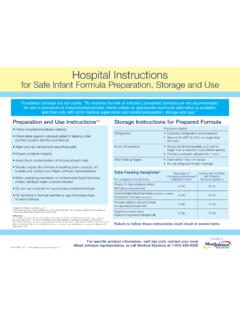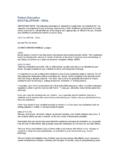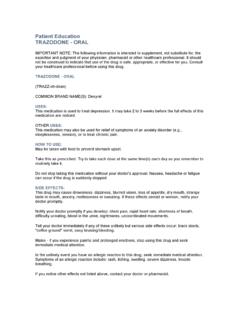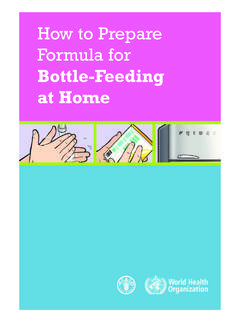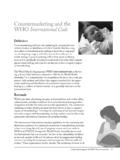Transcription of FEEDING THE NON-BREASTFED CHILD - WHO
1 WHO/FCH/ FEEDING THE NON-BREASTFED CHILD . 6-24 MONTHS OF AGE. Geneva, 8-10 March 2004. MEETING REPORT. For further information please contact: Department of CHILD and Adolescent Health and Development (CAH). World Health Organization 20 Avenue Appia 1211 Geneva 27. Switzerland tel + 41 22 791 32 81. fax + 41 22 791 48 53. website Department of Nutrition for Health and Development (NHD). World Health Organization 20 Avenue Appia 1211 Geneva 27 Department of CHILD and Adolescent Health and Development Switzerland Department of Nutrition for Health and Development tel + 41 22 791 33 26 World Health Organization fax + 41 22 791 41 59. website WHO/FCH/ FEEDING THE NON-BREASTFED CHILD 6-24 MONTHS OF AGE. FEEDING THE NON-BREASTFED CHILD . 6-24 MONTHS OF AGE. Geneva, 8-10 March 2004. MEETING REPORT. Department of CHILD and Adolescent Health and Development Department of Nutrition for Health and Development World Health Organization i FEEDING THE NON-BREASTFED CHILD 6-24 MONTHS OF AGE.
2 World Health Organization 2004. All rights reserved. Publications of the World Health Organization can be obtained from Marketing and Dissemination, World Health Organization, 20 Avenue Appia, 1211 Geneva 27, Switzerland (tel: +41 22 791 2476; fax: +41 22 791. 4857; email: Requests for permission to reproduce or translate WHO publications whether for sale or for noncommercial distribution should be addressed to Publications, at the above address (fax: +41 22. 791 4806; email: The designations employed and the presentation of the material in this publication do not imply the expression of any opinion whatsoever on the part of the World Health Organization concerning the legal status of any country, territory, city or area or of its authorities, or concerning the delimitation of its frontiers or boundaries. Dotted lines on maps represent approximate border lines for which there may not yet be full agreement.))
3 The mention of specific companies or of certain manufacturers' products does not imply that they are endorsed or recommended by the World Health Organization in preference to others of a similar nature that are not mentioned. Errors and omissions excepted, the names of proprietary products are distinguished by initial capital letters. The World Health Organization does not warrant that the information contained in this publication is complete and correct and shall not be liable for any damages incurred as a result of its use. ii FEEDING THE NON-BREASTFED CHILD 6-24 MONTHS OF AGE. Contents Introduction 1. Objectives of the meeting 2. Discussion themes 3. Conclusions 4. Amount of foods needed 4. Meal frequency and energy density 4. Nutrient content of foods 4. Use of fortified products or vitamin-mineral supplements 5. Fluid needs 5. FEEDING during and after illness 5.
4 Responsive FEEDING 5. Safe preparation and storage of foods 6. Duration of exclusive breastfeeding in the context of HIV 6. Publications following the meeting 6. Annex 1. List of participants 7. Annex 2. Agenda 10. Annex 3. Summary of presentations 13. Annex 4. Reports of the working groups 23. iii FEEDING THE NON-BREASTFED CHILD 6-24 MONTHS OF AGE. iv FEEDING THE NON-BREASTFED CHILD 6-24 MONTHS OF AGE. Introduction According to current UN recommendations, infants should be exclusively breastfed for the first six months of life, and thereafter should receive appropriate complementary FEEDING with continued breastfeeding up to two years or beyond. However, there are a number of infants who will not enjoy the benefits of breastfeeding in the early months of life or for whom breastfeeding will not occur or will stop before the recommended duration of two years or beyond.
5 A group that calls for particular attention is the infants of mothers who are known to be HIV positive. To reduce the risk of transmission, it is recommended that, when acceptable, feasible, affordable, sustainable and safe, these mothers give replacement FEEDING from birth. Otherwise, they should breastfeed exclusively and stop as soon as alternative FEEDING options become feasible. Another group includes those infants whose mothers have died, or who for some reason do not breastfeed. Recommendations for appropriate FEEDING of breastfed infants from six months onwards have been summarized by PAHO in the publication Guiding Principles for Complementary FEEDING of the breastfed CHILD . Some of these guiding principles are not applicable to non breast fed children, others need adaptation. WHO convened this informal meeting to identify an analogous set of guiding principles for FEEDING of NON-BREASTFED children after six months of age.
6 For infants less than six months, guidelines for decision makers and a guide for health care manager are already available. 1. PAHO. Guiding Principles for Complementary FEEDING of the breastfed CHILD . Washington: Pan American Health Organization, World Health Organization, 2003. 2. WHO/UNICEF/UNFPA/UNAIDS. HIV and infant FEEDING : Guidelines for decision-makers. WHO, 2003. and WHO/UNICEF/UNFPA/. UNAIDS. HIV and infant FEEDING : A guide for health-care managers and supervisors. WHO, 2003. 1. Introduction FEEDING THE NON-BREASTFED CHILD 6-24 MONTHS OF AGE. Objectives of the meeting FEEDING the NON-BREASTFED CHILD is difficult, especially in a context of poverty, because the risk of illness and mortality associated with not breastfeeding is exacerbated. With the present epidemic of HIV/AIDS striking particularly resource constrained countries, especially in sub Saharan Africa, how to feed the NON-BREASTFED infant and young CHILD needs to be urgently addressed.
7 With this in mind, participants were asked to: develop FEEDING recommendations for infants and young children 6-24 months of age who are not breastfed ;. discuss programme guidelines and tools for translating generic recommendations into locally appropriate FEEDING guidelines;. discuss sustainable options for increasing access to nutritious foods and/or micronutrients in resource-poor settings. 2. Objectives of the meeting FEEDING THE NON-BREASTFED CHILD 6-24 MONTHS OF AGE. Discussion themes The meeting brought together about 20 experts from a variety of disciplines and agencies (List of Participants, Annex 1). In preparation for the meeting, a background paper used available information from five countries (Bangladesh, Ghana, Guatemala, Honduras and Peru) to identify appropriate and affordable FEEDING options for similar settings considering various scenarios: where infant formula is available.
8 Where animal milk products are available;. where no animal milk products are available. In each of these scenarios, analysis was carried out using linear programming to determine what dietary recommendations should be formulated assuming the availability or not of other animal source foods. During the meeting, the current recommendations for FEEDING the breast fed CHILD were first examined to determine which guiding principles needed adaptation to be applicable to the non breast fed CHILD . Current recommendations for FEEDING HIV-positive infants and young children were also reviewed. Participants then reviewed up-to-date information on: scientific basis for guidelines on FEEDING NON-BREASTFED children 6-24 months of age;. caring for NON-BREASTFED infants and young children;. programmatic implications of FEEDING and taking care of NON-BREASTFED infant and young children.
9 The agenda and a summary of the presentations are attached as Annex 2 and 3. Working groups considered these inputs together with practical experiences of promoting appropriate FEEDING on a population basis and for children living in exceptionally difficult circumstances. The reports of the working groups are attached as Annex 4. 3. Discussion themes FEEDING THE NON-BREASTFED CHILD 6-24 MONTHS OF AGE. Conclusions Participants agreed on the following Guiding Principles for FEEDING the NON-BREASTFED CHILD 6-24 months of age: Amount of foods needed Energy needs are approximately 600 kcal/day at 6-8 months, 700 kcal/d at 9-11 months, and 900 kcal/d at 12-24 months of age. Meal frequency and energy density The appropriate number of feedings depends on the energy density of the local foods and the usual amounts consumed at each FEEDING . For the average healthy infant, meals should be provided 4-5 times per day, with additional nutritious snacks (such as a piece of fruit or bread or chapatti with nut paste) offered 1-2 times per day, as desired.
10 Meals include milk-only feeds, other foods, and combinations of milk feeds and other foods. Snacks are defined as foods eaten between meals - usually self-fed, convenient and easy to prepare. If energy density or amount of food per meal is low, more frequent meals may be required. Nutrient content of foods Feed a variety of foods to ensure that nutrient needs are met. Meat, poultry, fish or eggs should be eaten daily, or as often as possible, because they are rich sources of many nutrients such as iron and zinc. Milk products are rich sources of calcium and several other nutrients. Diets that do not contain animal source foods (meat, poultry, fish or eggs, plus milk products) cannot meet nutrient needs at this age unless fortified products or nutrient supplements are used. If adequate amounts of other animal source foods are consumed regularly, the amount of milk needed is ~200-400 mL/d; otherwise, the amount of milk needed is ~300-500 mL/d.










